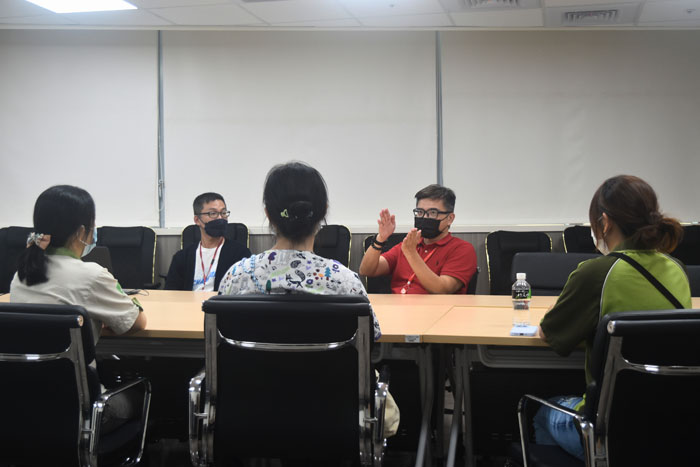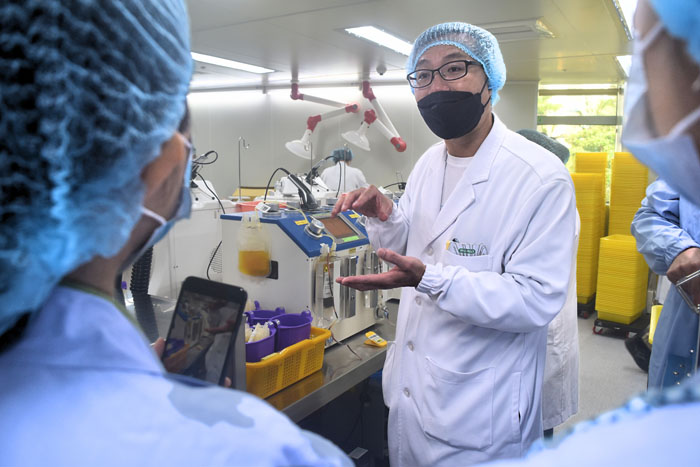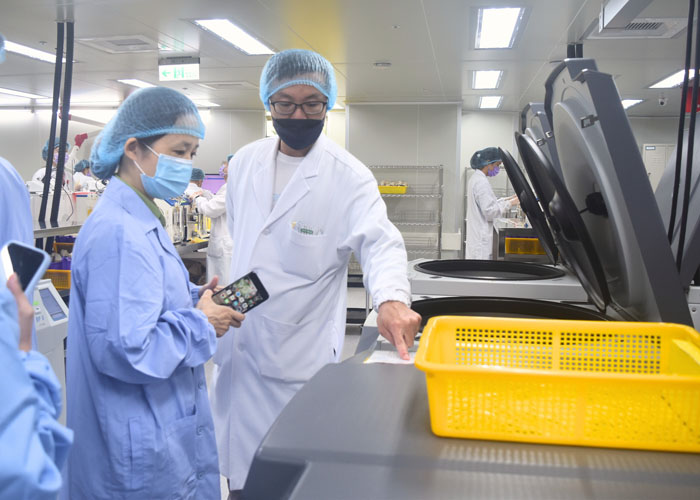Latest News
2025.04.28
News | Taiwan Blood Services Foundation ESG
- News
- Latest News
- Visiting the Blood Donation Center to Observe and Planning to Establish a Blood Bank: Taipei Zoo Aims to Save Endangered Animals!
Back to List
Visiting the Blood Donation Center to Observe and Planning to Establish a Blood Bank: Taipei Zoo Aims to Save Endangered Animals!
Latest News
2024.10.11
"We gained a lot today and now have a framework for what we need to do in the future." Upon the recommendation of National Taiwan University Hospital, to establish a blood bank for wild animals, Lai Yanxue, the head of the veterinary office at Taipei Zoo, along with three veterinary assistants, rushed to the Taipei Blood Center to observe and learn. They highly praised the center’s expertise in blood preservation.

Led by Lai Yanxue (front row, first from left), head of the veterinary office at Taipei Zoo, along with three veterinary assistants, they visited the Taipei Blood Center for observation. Yang Zhixin (back row, left), technical supervisor of the Blood Component Department, and Liu Junhong (back row, right), head of the Planning Department, provided explanations.
At 2 p.m. on September 5, Lai Yanxue and her team attentively listened to Yang Zhixin, the technical supervisor of the Blood Component Department at the Taipei Blood Center, as he explained the processes involved in blood component preparation, preservation, and testing. Afterward, the supervisor invited the team to visit the "Blood Component Department" on the second floor to observe the blood preparation process. After using a frozen centrifuge to separate the blood, the blood in the bags is divided into plasma on the top and blood cells on the bottom. Then, using a press machine (either automatic or manual), the blood bags are pressed to separate two bags of blood products while maintaining a sterile environment. Since the zoo handles a relatively small volume of blood, the opportunity to use an automatic press machine is rare, so a manual press operation was specially demonstrated. The zoo was particularly interested in the frozen red blood cell procedure. Yang explained, "Frozen red blood cells are mainly used to preserve rare blood type red cells. The key to the process is adding 57% glycerol to prevent the red blood cells from being damaged during freezing. These cells must be stored at -65°C or below for up to 10 years, and they require a special frozen storage bag. When needed, the glycerol is removed, producing glycerol-free frozen red blood cells, which have a shelf life of only 24 hours.
Looking to the Future: Preventing Animal Suffering
At the end of the observation, Lai Yanxue expressed that the zoo hopes to establish a plasma or serum bank for wild animals and explore what blood products could be used to treat sick animals in the future.
"We regularly perform health checks on animals, and if we could collect plasma while they’re healthy, we could use the stored blood products when they become ill. This is especially important for endangered wild animals, where obtaining plasma is very difficult. It can only be collected under anesthesia from existing animals, which poses significant challenges and risks. If we had such a blood bank, using the animal's own blood could avoid concerns about allergic reactions after transfusion."
Answering Every Question: A Framework After the Observation
This observation and learning opportunity was incredibly valuable for the zoo. Lai Yanxue mentioned that there had never been such a blood bank before, but if they could build a proper inventory in the future, it would greatly benefit animal healthcare.
She believes the biggest takeaway from the visit was learning about the plasma preparation process and gaining a better understanding of the equipment. Now, they have a clearer idea of what materials and equipment to purchase in the future and how to utilize the blood products effectively, including handling them during use. The remaining challenge might be how to transfer these concepts and technologies to animals. The NTU Veterinary Hospital will also be one of the places to learn from.
Establishing a blood bank for rare animals is an extremely ambitious undertaking, but Taipei Zoo is determined to make it happen for the sake of the animals' health. Fortunately, the Taipei Blood Center has extensive expertise in building blood banks, as well as in the production and preservation of blood products. The team's thoughtful questions greatly encouraged the staff at the Taipei Blood Center. The department head generously shared his 27 years of knowledge and operational developments, including the differences between manual and automated systems, inspiring the zoo team to find corresponding, suitable methods and leaving them with much valuable insight.

The zoo inquired about the operation of manual equipment, and a medical technologist gave a special demonstration.

Yang Zhixin explained the process and preservation of blood products.

The supervisor explained the specifications and function of the frozen centrifuge to Lai Yanxue, head of the veterinary office at Taipei Zoo.

Led by Lai Yanxue (front row, first from left), head of the veterinary office at Taipei Zoo, along with three veterinary assistants, they visited the Taipei Blood Center for observation. Yang Zhixin (back row, left), technical supervisor of the Blood Component Department, and Liu Junhong (back row, right), head of the Planning Department, provided explanations.
At 2 p.m. on September 5, Lai Yanxue and her team attentively listened to Yang Zhixin, the technical supervisor of the Blood Component Department at the Taipei Blood Center, as he explained the processes involved in blood component preparation, preservation, and testing. Afterward, the supervisor invited the team to visit the "Blood Component Department" on the second floor to observe the blood preparation process. After using a frozen centrifuge to separate the blood, the blood in the bags is divided into plasma on the top and blood cells on the bottom. Then, using a press machine (either automatic or manual), the blood bags are pressed to separate two bags of blood products while maintaining a sterile environment. Since the zoo handles a relatively small volume of blood, the opportunity to use an automatic press machine is rare, so a manual press operation was specially demonstrated. The zoo was particularly interested in the frozen red blood cell procedure. Yang explained, "Frozen red blood cells are mainly used to preserve rare blood type red cells. The key to the process is adding 57% glycerol to prevent the red blood cells from being damaged during freezing. These cells must be stored at -65°C or below for up to 10 years, and they require a special frozen storage bag. When needed, the glycerol is removed, producing glycerol-free frozen red blood cells, which have a shelf life of only 24 hours.
Looking to the Future: Preventing Animal Suffering
At the end of the observation, Lai Yanxue expressed that the zoo hopes to establish a plasma or serum bank for wild animals and explore what blood products could be used to treat sick animals in the future.
"We regularly perform health checks on animals, and if we could collect plasma while they’re healthy, we could use the stored blood products when they become ill. This is especially important for endangered wild animals, where obtaining plasma is very difficult. It can only be collected under anesthesia from existing animals, which poses significant challenges and risks. If we had such a blood bank, using the animal's own blood could avoid concerns about allergic reactions after transfusion."
Answering Every Question: A Framework After the Observation
This observation and learning opportunity was incredibly valuable for the zoo. Lai Yanxue mentioned that there had never been such a blood bank before, but if they could build a proper inventory in the future, it would greatly benefit animal healthcare.
She believes the biggest takeaway from the visit was learning about the plasma preparation process and gaining a better understanding of the equipment. Now, they have a clearer idea of what materials and equipment to purchase in the future and how to utilize the blood products effectively, including handling them during use. The remaining challenge might be how to transfer these concepts and technologies to animals. The NTU Veterinary Hospital will also be one of the places to learn from.
Establishing a blood bank for rare animals is an extremely ambitious undertaking, but Taipei Zoo is determined to make it happen for the sake of the animals' health. Fortunately, the Taipei Blood Center has extensive expertise in building blood banks, as well as in the production and preservation of blood products. The team's thoughtful questions greatly encouraged the staff at the Taipei Blood Center. The department head generously shared his 27 years of knowledge and operational developments, including the differences between manual and automated systems, inspiring the zoo team to find corresponding, suitable methods and leaving them with much valuable insight.

The zoo inquired about the operation of manual equipment, and a medical technologist gave a special demonstration.

Yang Zhixin explained the process and preservation of blood products.

The supervisor explained the specifications and function of the frozen centrifuge to Lai Yanxue, head of the veterinary office at Taipei Zoo.
Share on
-
Copied to clipboard
Latest News
2024.12.14
